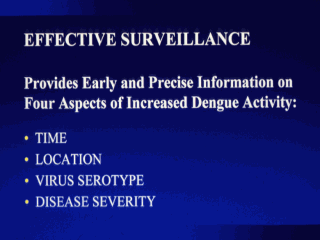 |
The intent of an effective surveillance system is to provide early and precise information to public health officials on four aspects of increased dengue activity:
Time; Location; Virus Serotype; and Disease Severity. The purpose would be to reduce transmission, thereby reducing the probability of dengue hemorrhagic fever/dengue shock syndrome. It should, therefore, be a proactive surveillance system that will allow for early detection of dengue cases and thus will improve the capacity of public health officials to prevent and control the spread of dengue. The most significant characteristic of this type of surveillance is its predictive capability. Analysis of trends of reported cases, the establishment of sentinel clinics, the confirmation of dengue cases by the laboratory, and the rapid identification of the serotypes involved in transmission, provide the necessary information to predict dengue transmission and guide implementation of control measures well in advance of peak transmission. Proactive clinical surveillance must be linked to entomologic surveillance, in order to identify dengue transmission in time and place.
If effectively applied at this stage, mosquito control measures might abort an incipient epidemic. Vigilance would have to be maintained for some time, however, to ensure that the epidemic was not simply delayed. To achieve this type of predictive capability for epidemic dengue, the active surveillance system must be laboratory-based and must use rapid and sensitive laboratory diagnostic methods. A laboratory-based surveillance system of this type will provide information on the onset, location, infecting virus serotype, and severity of the disease. It also will allow prompt reporting of results to submitting clinics and health care personnel and the ability to obtain further information, if necessary, on cases of severe disease or of public health importance. Thus, a good diagnostic laboratory is essential to an effective active surveillance system.
|
